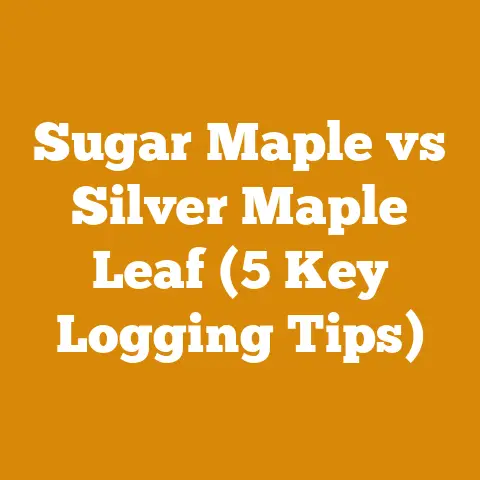Bradford Pear Pruning Tips (Zone 7A Tree Topping Guide)
Bradford Pear Pruning in Zone 7a: A Controversial Topping Guide and Cost Implications for Wood Processing
I remember seeing old Mr. Henderson down the street meticulously pruning his Bradford pear every spring.
He swore it kept the tree blooming beautifully.
Turns out, his approach, while common, was a lesson in what not to do.
The Bradford pear, a once-ubiquitous ornamental tree, has become a bit of a poster child for horticultural mistakes.
While its spring blooms are undeniably stunning, its weak wood and tendency to split make it a high-maintenance and often short-lived addition to the landscape.
And the practice of “topping” – a drastic pruning method – only exacerbates these problems.
This article isn’t just about how to prune a Bradford pear; it’s about why you might want to reconsider owning one in the first place, and if you do have one, how to manage it responsibly, including a discussion of the costs associated with different pruning and removal strategies.
We’ll also delve into the potential for using the wood (if you’re brave enough!) and the costs that come with that.
Understanding the Bradford Pear Problem
Before we dive into pruning techniques, it’s crucial to understand why Bradford pears are so problematic.
- Weak Branch Structure: Bradford pears are notorious for their tight, V-shaped crotches.
This formation makes them prone to splitting and breaking, especially under heavy snow or strong winds. - Invasive Potential: Bradford pears are prolific seed producers.
Their seeds are spread by birds, leading to the establishment of invasive thickets in natural areas.
This outcompetes native species and disrupts ecosystems. - Short Lifespan: Even with proper care, Bradford pears typically live only 15-25 years.
Therefore, while topping might seem like a quick fix for overgrown branches, it actually weakens the tree further, creating even more opportunities for breakage and decay.
And ultimately, it doesn’t solve the underlying problem of a poorly structured tree.
The Controversy of Topping Bradford Pears
Topping, in essence, is the indiscriminate cutting back of tree branches to stubs.
It’s often done to reduce the tree’s height or spread quickly.
While it might seem like a simple solution, it has several detrimental consequences:
- Weakened Structure: Topping removes the terminal buds, which inhibit the growth of lateral branches.
This results in a proliferation of weak, upright shoots called water sprouts.
These sprouts are weakly attached and prone to breaking. - Increased Risk of Disease and Decay: Large cuts expose the tree to disease and decay organisms.
The tree must expend a significant amount of energy to seal these wounds, diverting resources from other essential functions. - Unattractive Appearance: Topped trees often have a disfigured, unnatural appearance.
The dense cluster of water sprouts creates a “witch’s broom” effect. - Reduced Lifespan: Topping significantly shortens the tree’s lifespan by weakening its structure and increasing its susceptibility to disease.
Why People Top Anyway (And Why It’s a Bad Idea):
People often top Bradford pears because:
- They want to reduce the tree’s height quickly.
- They believe it will make the tree stronger (ironically, the opposite is true).
- They lack the knowledge of proper pruning techniques.
However, the long-term consequences of topping far outweigh any perceived short-term benefits.
Alternative Pruning Strategies for Bradford Pears in Zone 7a
If you have a Bradford pear and are committed to keeping it, there are better ways to manage its growth than topping.
These strategies focus on maintaining the tree’s health and structure while minimizing the risk of breakage.
- Structural Pruning: This involves selectively removing branches to create a strong, well-balanced framework.
The goal is to eliminate tight crotches and promote outward growth. - Crown Thinning: This involves removing a portion of the branches throughout the crown of the tree to increase light penetration and air circulation.
This helps to reduce the density of the canopy and minimize the risk of wind damage. - Reduction Cuts: These cuts are made back to a lateral branch that is at least one-third the diameter of the branch being removed.
This helps to reduce the length of branches without creating stubs.
Specific Pruning Techniques:
- Remove crossing, rubbing, or interfering branches. These branches can create wounds that provide entry points for disease and decay.
- Eliminate branches with narrow crotch angles. These are the branches that are most likely to split.
- Shorten excessively long branches. This helps to reduce the weight on the ends of the branches and minimize the risk of breakage.
- Maintain a central leader. This is the main trunk of the tree.
Pruning should be done to encourage the growth of the central leader.
Timing is Key:
The best time to prune Bradford pears is in late winter or early spring, before new growth begins.
This allows the tree to heal quickly and reduces the risk of disease.
However, you can also do some light pruning in the summer to remove water sprouts or correct minor structural problems.
The Cost of Pruning and Maintaining a Bradford Pear
Let’s talk numbers.
Pruning costs for a Bradford pear can vary considerably depending on the size of the tree, its condition, and the location.
DIY Pruning:
- Tools: A good pair of pruning shears can cost $20-$50.
A pruning saw might run $30-$75.
If the tree is larger, you might need a pole pruner, which can cost $50-$150.
I always recommend investing in quality tools; they last longer and make the job easier. - Time: Pruning a small Bradford pear yourself might take a few hours.
A larger tree could take a full day or more.
Remember to factor in the cost of your time! - Safety Gear: Safety glasses ($10-$20) and gloves ($10-$30) are essential.
A helmet ($30-$70) is a good idea for larger trees. - Disposal: You’ll need to dispose of the branches.
This could involve hauling them to a local yard waste facility (fees vary) or chipping them yourself.
A wood chipper rental can cost $75-$150 per day.
Professional Pruning:
- Cost: Professional tree pruning services typically charge $75-$150 per hour, or $200-$800 for the entire job, depending on the size and complexity of the tree.
- Benefits: Professionals have the knowledge, experience, and equipment to prune your Bradford pear safely and effectively.
They can also identify and address any underlying health problems. - Considerations: Get quotes from several different companies before hiring someone.
Ask for references and check their insurance coverage.
Table: Estimated Pruning Costs for Bradford Pear (Zone 7a)
Note: These are estimates, and actual costs may vary depending on your location and the specific circumstances of your project.
The Ultimate Solution: Bradford Pear Removal and Replacement
Given the inherent problems with Bradford pears, the most responsible course of action is often to remove the tree altogether and replace it with a more desirable species.
Cost of Removal:
- DIY Removal: Removing a Bradford pear yourself is a dangerous and labor-intensive task.
It’s generally not recommended unless you have experience with tree felling and the proper equipment. - Professional Removal: Professional tree removal services typically charge $300-$1,000 or more, depending on the size of the tree, its location, and the presence of any obstacles (e.g., power lines, buildings).
- Stump Grinding: Stump grinding typically costs $100-$300, depending on the size of the stump.
Leaving the stump can attract pests and diseases.
Cost of Replacement:
- Tree Cost: The cost of a replacement tree can range from $50-$500 or more, depending on the species, size, and container size.
- Planting Cost: Planting a tree yourself is relatively inexpensive (a few dollars for amendments and mulch), but it requires some physical labor.
Professional planting services typically charge $50-$200 or more, depending on the size of the tree and the complexity of the job.
Table: Estimated Removal and Replacement Costs for Bradford Pear (Zone 7a)
Note: These are estimates, and actual costs may vary depending on your location and the specific circumstances of your project.
Choosing a Replacement Tree:
When selecting a replacement tree, consider native species that are well-suited to your climate and soil conditions.
Some excellent alternatives to Bradford pears include:
- Serviceberry (Amelanchier spp.): These native trees offer beautiful spring blooms, edible berries, and attractive fall foliage.
- Dogwood (Cornus florida): Dogwoods are known for their showy bracts (modified leaves) that surround the true flowers.
They also provide valuable habitat for wildlife. - Redbud (Cercis canadensis): Redbuds are small, deciduous trees with vibrant pink flowers in the spring.
Bradford Pear Wood: Can You Use It? And What’s the Cost?
Okay, so you’ve removed your Bradford pear.
Now what?
Can you use the wood?
The answer is… maybe.
The Challenges:
- Weak Wood: Bradford pear wood is relatively soft and prone to splitting.
It’s not ideal for structural applications. - Small Size: Bradford pears are typically small trees, so you won’t get a lot of usable lumber.
- Warping: The wood is prone to warping and twisting as it dries.
Potential Uses:
- Firewood: Bradford pear wood can be used as firewood, although it’s not the highest-quality fuel.
It burns relatively quickly and doesn’t produce a lot of heat.
The cost of using it for firewood is primarily your time for cutting, splitting, and stacking.
Remember to season the wood properly (6-12 months) to reduce its moisture content. - Small Craft Projects: The wood can be used for small craft projects, such as carving, whittling, or turning.
Its fine grain can make it attractive for decorative items. - Chipping for Mulch: Chipping the wood for mulch is a good way to recycle the tree and improve your garden.
Cost Considerations for Processing Bradford Pear Wood:
Let’s break down the costs involved in processing Bradford pear wood:
- Chainsaw: If you don’t already own one, a decent chainsaw can cost $150-$500.
I’ve found that a mid-range saw is sufficient for most homeowners. - Chainsaw Maintenance: Chainsaw maintenance includes sharpening the chain (files cost $10-$30), oiling the chain (oil costs $10-$20 per gallon), and replacing the chain periodically (chains cost $20-$50).
- Wood Splitter: Splitting Bradford pear wood by hand is possible, but a wood splitter makes the job much easier.
A manual wood splitter can cost $100-$300.
A gas-powered wood splitter can cost $1,000-$3,000.
Rental costs are around $75-$150 per day. - Time: Processing Bradford pear wood takes time and effort.
Figure that you will spend at least several hours cutting, splitting, and stacking the wood. - Drying: Properly drying the wood takes time and space.
You’ll need to stack the wood in a well-ventilated area for at least 6-12 months. - Chipper Rental: Renting a chipper is around $75-$150 per day.
Table: Estimated Costs for Processing Bradford Pear Wood
Note: These are estimates, and actual costs may vary depending on your location and the specific circumstances of your project.
Is it Worth It?
Ultimately, whether or not it’s worth the effort to process Bradford pear wood depends on your individual circumstances.
If you need firewood, have the time and equipment, and enjoy the process, then it might be a worthwhile endeavor.
However, if you’re short on time or space, or if you’re looking for high-quality lumber, then you might be better off simply disposing of the wood.
Budgeting for Your Bradford Pear Project
Whether you choose to prune, remove, or process your Bradford pear, it’s essential to create a budget to avoid overspending.
Steps to Create a Budget:
- Assess the Situation: Determine the size and condition of your Bradford pear.
- Choose a Strategy: Decide whether you want to prune, remove, or process the tree.
- Gather Estimates: Get quotes from several different companies for professional services.
- Calculate DIY Costs: Estimate the cost of tools, materials, and disposal if you plan to do the work yourself.
- Factor in Time: Consider the amount of time it will take to complete the project and the value of your time.
- Add a Contingency: Include a contingency fund (10-20%) to cover unexpected expenses.
Example Budget (Removal and Replacement):
- Professional Tree Removal: $600
- Stump Grinding: $200
- Replacement Tree (Serviceberry): $150
- Planting (DIY): $20
- Contingency (10%): $97
- Total Estimated Cost: $1,067
Tips for Cost Optimization:
- Do it Yourself (Carefully): If you’re comfortable with basic tree care tasks, you can save money by doing some of the work yourself.
However, be sure to prioritize safety and avoid taking on tasks that are beyond your skill level. - Shop Around: Get quotes from several different companies before hiring someone.
- Consider Seasonal Discounts: Some tree care companies offer discounts during the off-season (e.g., winter).
- Recycle the Wood: Use the wood for firewood, mulch, or small craft projects.
- Plant a Smaller Tree: Smaller trees are less expensive and easier to plant.
- Choose a Native Species: Native trees are often more resistant to pests and diseases, which can save you money on maintenance costs in the long run.
- Check Local Programs: Some municipalities offer rebates or incentives for planting native trees.
Actionable Takeaways and Next Steps
Dealing with a Bradford pear can be a frustrating experience, but with the right knowledge and planning, you can make informed decisions about how to manage it.
Key Takeaways:
- Topping Bradford pears is detrimental to their health and structure.
- Alternative pruning strategies can help to maintain the tree’s health and minimize the risk of breakage.
- Removing the tree altogether and replacing it with a more desirable species is often the most responsible course of action.
- Bradford pear wood can be used for firewood, small craft projects, or mulch, but it’s not ideal for structural applications.
- Creating a budget is essential for avoiding overspending on your Bradford pear project.
Next Steps:
- Assess Your Bradford Pear: Evaluate its size, condition, and location.
- Choose a Strategy: Decide whether you want to prune, remove, or process the tree.
- Gather Information: Research proper pruning techniques, removal options, and wood processing methods.
- Create a Budget: Estimate the cost of the project and identify potential cost savings.
- Take Action: Implement your chosen strategy and enjoy the benefits of a healthier, more sustainable landscape.
Remember Mr. Henderson?
He eventually replaced his topped Bradford pear with a beautiful serviceberry.
It was a much better choice, both for his yard and the local ecosystem.
And that’s the real lesson here: sometimes, the best solution is to start fresh.
So, put on your thinking cap, grab your tools (or your phone to call a professional), and get started on your Bradford pear project today!
You’ll be glad you did, and your landscape will thank you.





